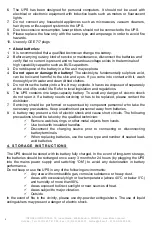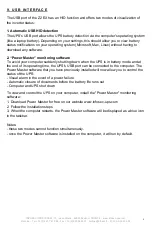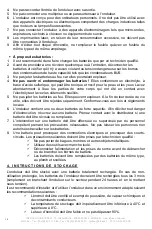
INFOSEC UPS SYSTEM - 15, rue du Moulin - 44880 Sautron - FRANCE - www.infosec-ups.com
Hot Line – Tel + 33 (0)2 40 76 15 82 - Fax + 33 (0)2 40 94 29 51 - [email protected] – 07 19 AA 36 205 08
3
2. Do not install the UPS system near water or in moist environments.
3. Do not install the UPS system where it would be exposed to direct sunlight or near
heater.
4. For safe operation, the UPS must be installed in a non confined area with good
ventilation for optimal circulation of air at room temperature. Ensure enough space on
each side for ventilation.
5. Do not place anything on the UPS and leave a space of about 20cm around the UPS,
otherwise there is a risk that it may overheat or even cause a fire.
6. The mains outlet that supplies the UPS must be located near the UPS and be easily
accessible.
7. Install the UPS in a temperature and humidity-controlled room free of conductive
interference.
8. Disconnect the UPS from AC power and switch it off before cleaning with a damp
cloth (no cleaning products).
9. Do not leave any recipients containing liquid on or near the UPS.
10. Place cables in such a way that no one can step on or trip over them.
11. Prevent no fluids or other foreign objects from inside of the UPS system
Risk of electric shock:
1. The UPS unit uses potentially hazardous voltages. Do not attempt to disassemble this
equipment as it does not contain accessible components that can be repaired by
users, fuse change excepted.
2. Caution : risk of electric shock. The battery circuit is not isolated from the input
voltage. Hazardous voltages may occur between the battery terminals and the
ground. Before touching, please verify that no voltage is present!
3. The UPS system operates with hazardous voltages. Repairs may be carried out only
by qualified maintenance personnel.
4. The utility power outlet must be near the equipment and be easily accessible. To
isolate the UPS from AC input and swith it off, remove the plug from the utility power
outlet.
5. Do not disconnect the mains cable on the UPS system or the building wiring outlet
(earthed shockproof socket outlet) during operations since this would cancel the
protective earthing of the UPS system and of all connected loads.
6. The UPS has its own internal power supply (battery). There is a risk that output
sockets may still be live after the UPS has been disconnected from the mains power
supply.
7. In an emergency situation, switch the UPS to the “Off” position and disconnect the
unit from the AC power supply.
8. When the UPS is out of order, please refer to section:
“trouble shooting
” and call the
hot line.
9. Equipotential earth bonding must be checked with external battery bank if any
Connected products:
1. Combined UPS and connected equipment leakage current should not exceed 3,5 mA.
2. Make sure that the connected load does not exceed UPS capabilities. To ensure
improved backup time and longer battery life, we recommend a load equivalent to 1/3
of nominal power.
3. Do not connect appliances or devices which would overload the UPS (e.g. big motor-
type equipment)) to the UPS output sockets or terminal.
4. Do not plug the UPS input into its own output socket.
5. Do not plug the UPS into a power strip or surge suppressor.




































